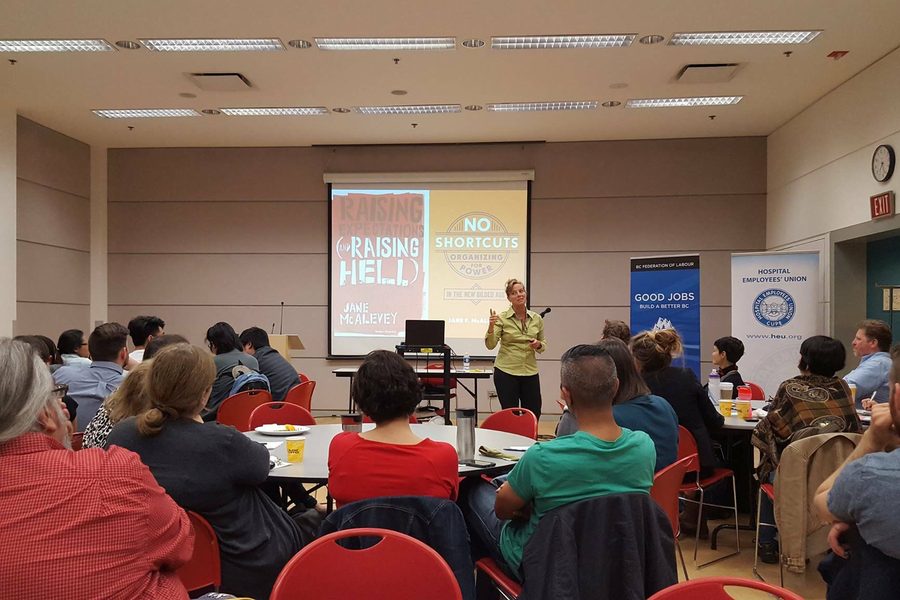A Q&A with Jane McAlevey: “We Can Turn This Thing Around More Quickly Than Most People Think”
The longtime labor organizer reflects on the election and talks about where we go from here.
Kate Aronoff

If one mantra seems to have dominated the progressive response to this year’s presidential election, it’s an apocryphal one cribbed from a long-dead Swedish Wobbly: “Don’t mourn, organize!” Exactly what that organizing looks like, however, remains up for debate.
Jane McAlevey’s latest book, No Shortcuts: Organizing for Power in the New Gilded Age, sets out to shed light on that question, drawing on case studies from recent history and McAlevey’s three decades of experience in the labor and environmental movements. McAlevey’s work — like that of her dissertation advisor, Frances Fox Piven — looks to reinsert the role of ordinary people back into our understanding of power and politics, refocusing away from both the horse race of presidential elections and top-down mobilizing strategies that draw in only those already committed to left and liberal causes. As pundits and progressive groups alike struggle to understand what happened on Election Day, McAlevey makes a relatively straightforward argument: listen. Key to beating Donald Trump and Trumpism, she contends, is getting outside the echo chamber of existing activist networks, tapping into the disruptive power of ordinary — and organized — people.
On the day after the election, In These Times spoke with McAlevey by phone about Trump, Bernie Sanders, the future of the labor movement and why not all hope is lost.
To start off, what do you think happened last night?
Well, I definitely wasn’t surprised. In the summer of 2015 when all this madness began, I was on record with a lot of people saying that Trump was going to win the Republican Party’s nomination. People would say, “Isn’t it great that we have this buffoon running because it’ll be fun for comedy shows and show such a stark contrast to the Democratic Party?” I don’t think bringing every racist out from under the rock they’ve been sitting under is funny.
I had a gut feeling that he was going to win the presidency way back. But at that point I still had an inkling of hope that the trade union leadership within the Democratic Party would have enough wisdom to endorse Sanders, or [Elizabeth] Warren, or someone who stood a chance at defeating Trump. Then in March, I sent a series of emails to a bunch of national groups I consult for saying we should convene a table to discuss what the movement should do the day after Trump wins — literally, a November 10th plan. I was being agitational in those emails because I was trying to force people to reckon with the implications of letting Hillary [Clinton] get the nomination over Sanders, and trying to get people to imagine a Trump victory.
Organizers’ best skill is that we listen, and I was out in the field thinking that union and party leadership were totally out of touch with what the base was saying and how angry they were. I was frenetic in March because I saw this coming, and it seemed clear that we had a “throw the bums out” moment happening and needed to put up a candidate that was an outsider to stand a chance against the Republicans putting up an outsider candidate.
The levels of denial in leadership were profound. People were denying that Trump was going to be the nominee and saying that Hillary would be the right candidate. But none of it really stacked up if you were actually out dealing with ordinary Americans across the country, and if you weren’t locked up in some D.C. punditry circle or New York City elite circle. In 2010 and again 2014, we lost the country at the statehouse level. When you look at what’s happened over the last several years in places like Michigan — losing the state constitutional proposition on collective bargaining at the ballot box — and Wisconsin — losing the recall and re-electing [Gov. Scott] Walker — why anyone is surprised today is crazy to me. I don’t know why it seemed so odd to folks that the GOP would take a trifecta [the executive branch and the upper and lower houses of the legislature] at the national level like it did successfully in 2010 and 2014 in so many states, including ones Trump won.
So I woke up today thinking that there were dozens of signs that he would be president. A lot of poor decisions were made, against really strong evidence.
At the risk of asking the same question everyone is asking right now, where do we go from here?
The questions I want to focus on now are about the things we do control. There are certain things we don’t control as progressives and trade unionists. But there are certain things that we can control. We can control our strategy. I’m always telling people we need to do a power structure analysis and they always say we don’t have time. And I say we do, because if we don’t do it we’ll lose. My entire life in the movement has been running into leaders who at every turn choose shortcuts and think they’re going get us somewhere. And they don’t.
From the time I came into the movement, there have been a set of truisms. One of them is the importance of serious, deep base building, and what I like to think of as real organizing. There are so few people with resources focusing on real organizing. It feels so empty right now. We need a back-to-basics approach to organizing that has been just consistently thrown out in favor of corporate campaigns, top-down work, advocacy, Facebook, tweeting — screw it all — this big data stuff that has infected the house of labor. Those of us talking to workers know that the workers are telling us something else.
Post-election, there seems to be an impulse in the progressive world toward what you call mobilization — getting an existing base together, people who are already going to meetings and signing petitions. In this moment, what do you think deep organizing, as you call it, can offer?
Even among people who I love, there’s very little understanding of the difference between an activist — people who are already totally committed to the cause — and a real or natural leader, who comes from the vast universe of ordinary people who are not yet engaged in any of our movements. First, we need to have a strategy where we spend most of our time focusing on the undecideds, on the people not in our Twitter feeds. Our base is simply too small right now. Forty-five years of just doing mobilizing and advocacy has let us cede a large base of people who were with us in some loose framework and left them adrift, left them somewhere very confused. To me, that’s why whole worker organizing is crucial. Organizing people only in their communities has never added up to the kind of power that’s required to challenge multinational capital.
And we’re not going to outspend them. Being in a swing state, Pennsylvania, there were seven ads for [Republican Senate candidate] Pat Toomey to every one ad for [Democratic Senate candidate] Kate McGinty. That kind of campaign financing will not change anytime soon. We only have one choice in the foreseeable future, which is to figure out how workers can return to creating massive disruptions — to shut down capital, workplace by workplace.
There has been such inattention to the fundamentals of the work for so long. You don’t just wake up in the morning and have some college students march on a big building on Wall Street and think that we’ve won. If you look at people who claim the leadership in the more activist side of the trade union movement or in the climate change movement, for instance, none of them are talking about real organizing. They talk about mobilizing and the technology of turnout, not about what it means to spend your life talking to the not yet converted: How you find them? How do you build a structure around them?
What’s also scary to me is how much money unions spent trying to get Hillary elected. If you gave those resources to real organizers, you might have had a different outcome.
Going into the Trump administration, what do you see as the biggest fights coming up in the months and years ahead?
It’s always been vicious for some people, but I think today is the most dangerous moment of my lifetime, because of the level of total control that the GOP now has.
Trump has both houses of Congress, and Breitbart [News] ran the campaign. There needs to be [a] whole bunch of defensive blocking action, but part of what is so intimidating about this moment is that when Democrats come in with majorities in both houses, we barely do anything: We set up committees, hold hearings and coalition-build. When they come in with all of these trifecta red legislatures and governors’ offices, they don’t mess around. Just look at what Scott Walker did in Wisconsin, and what [Gov. Bruce] Rauner has done in Illinois.
If you look at how fast they move when they have total control, I would ask if national right-to-work legislation is going to come on day one of Trump’s administration, or day two?
What’s not going to work in this moment are shallow protests, like getting 10 people arrested on a bridge. Who gives a shit? Do a power analysis — really dig into the numbers and all of the things happening at the state level. I don’t have the answer to what we do tomorrow, but what we damn well better understand is the difference between mobilizing and advocacy and deep organizing. There is a serious layer of younger leaders who are tremendous activists that don’t get organizing. And it scares the hell out of me.
For 20 years, progressive philanthropy and the SEIUs of the world have continually made horribly misguided decisions about where they’re investing their resources. If we had done things differently when Republicans took the House in 2010, would we have had a different result? Hell yeah.
We need a massive resetting of the priorities of the movement. Our objective has to be spending 90 percent of our time working with and helping the undecideds sitting out there understand who’s really to blame for why they feel so much pain. People are pissed. Half the people who voted for Trump would have voted for a different candidate if we had given them one who in any way spoke to their needs. I don’t think the country is lost. But we’re in a very scary moment. The GOP is going to make devastating structural changes. The only way to defeat them is if we can get more people onto our side, and outlast them with sustained and massive disruption.
My experience is that ordinary people have always been ready. What workers need in a tough fight is confidence in a plan to win. And when they can see it and touch it and paint it — and are deeply involved in crafting that plan — they’ll quickly rise to it.
Anything else you want to add?
We can turn this thing around more quickly than most people think. Most people are actually with us and not with Trump. It’s totally doable. It’s a question of who’s controlling resources and if they are ready to realize the error of their shallow leadership for the past 20 years.
Kate Aronoff is a staff writer at The New Republic and author of Overheated: How Capitalism Broke the Planet — And How We Fight Back. She is co-author of A Planet To Win: Why We Need a Green New Deal and co-editor of We Own the Future: Democratic Socialism—American Style. Follow her on Twitter @katearonoff.








